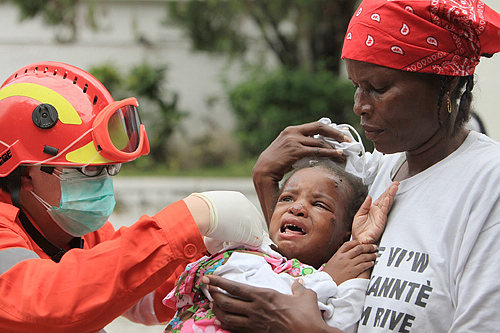|
 |
|
DEDICATED HELPER: A doctor with the CISAR treats an injured child in Port-au-Prince, Haiti, on January 14, 2010 (XINHUA) |
Another detector identifies the sounds made by trapped people. The device has six vibration sensors and uses echolocation to pinpoint survivors. Even if a survivor can no longer speak, as long as he or she can make any tiny sound, such as knocking something with fingers, the sound can be "heard." In theory the detector can sense even a survivor's faintly beating heart.
The third type of detector is a radar that sends electro-magnetic signals into the rubble. The signals reveal whether or not targets within the rubble are still moving.
The CISAR also has state-of-the-art rescue robots at its disposal. Developed by the Shenyang Institute of Automation, under the Chinese Academy of Sciences, these robots can do the work of human rescuers especially in areas where there is a high risk of after shocks and further collapse.
These advanced machines were used after the powerful earthquake in Yushu County, Qinghai Province, on April 14, 2010. On one occasion, rescue robots detected traces of life under the rubble and four hours later, four survivors were rescued, while no one was hurt during the operation.
Advanced equipment needs experienced and professional operators to be effective.
"While hi-tech equipment is indispensable, people with their judgments, experience and expertise are instrumental," Wang said.
In the eyes of Wang Hongguo, the CISAR's head, the strength of his rescue team is not simply a matter of its cutting-edge equipment, but rather true dedication rooted in the team's people-oriented philosophy.
"Being people-oriented is fundamental to a rescue team. As long as there is a slim chance, we must not give up. We must do our best to get people out," Wang Hongguo said.
The CISAR does not only want to save lives as soon as possible, but also in the safest and most effective way.
It was reported in Dujiangyan Hospital after the Wenchuan earthquake, a rescue team was attempting to pull an old man, whose left hand and leg were pinned down by a heavy beam, out from the rubble. After hours of efforts, desperate team members decided to amputate the crushed limbs. However, at this critical moment, CISAR members arrived. They sized up the situation and made a painstaking effort to save the survivor's life and limbs. Three hours later, they succeeded in releasing the man without resorting to amputation.
The CISAR breaks its operations down into three steps. First members evaluate a disaster's impact and define a work area, then they gather information on likely survivor locations by speaking to local residents and using sniffer dogs and life detectors. Finally they work to extract survivors.
"At times of life and death, the devil is in the details," said Wang Nianfa, a veteran team member who has been on all but one of CISAR's overseas operations in the past decade.
Grueling training
At the foot of Fenghuang Ridge in Beijing's western suburbs, there is a disaster zone. Wrecked buildings are tilted, exposing the steel structure inside. Rubble is piled up like hills, the cars are smashed and roads are clogged.
This is the CISAR's training ground—a 13-hecture field covered by debris.
The training base was built in 2008 and cost 210 million yuan ($32.63 million). The base is the first of its kind in China, said Wu Jianchun, Director of the National Earthquake Response Support Service.
"We have a vibrant team of experienced instructors and internationally advanced facilities," Wu said.
| 